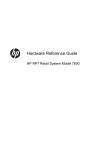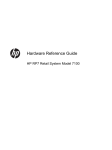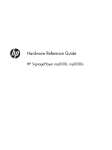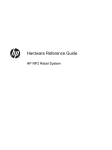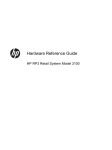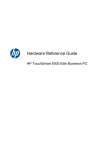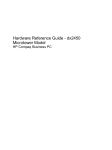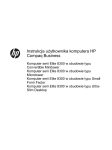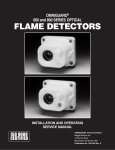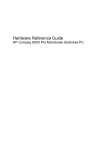Download HP RP7 Hardware Reference Manual
Transcript
Hardware Reference Guide HP RP7 Retail System Model 7800 © Copyright 2012 Hewlett-Packard Development Company, L.P. The information contained herein is subject to change without notice. Microsoft, Windows, and Windows Vista are either trademarks or registered trademarks of Microsoft Corporation in the United States and/or other countries. The only warranties for HP products and services are set forth in the express warranty statements accompanying such products and services. Nothing herein should be construed as constituting an additional warranty. HP shall not be liable for technical or editorial errors or omissions contained herein. This document contains proprietary information that is protected by copyright. No part of this document may be photocopied, reproduced, or translated to another language without the prior written consent of Hewlett-Packard Company. Hardware Reference Guide HP RP7 Retail System Model 7800 Second Edition (November 2012) Document Part Number: 697971-002 About This Book This guide provides basic information for upgrading this computer model. WARNING! Text set off in this manner indicates that failure to follow directions could result in bodily harm or loss of life. CAUTION: Text set off in this manner indicates that failure to follow directions could result in damage to equipment or loss of information. NOTE: ENWW Text set off in this manner provides important supplemental information. iii iv About This Book ENWW Table of contents 1 Product Features ............................................................................................................................................ 1 Standard Features ................................................................................................................................ 1 Optional HP RP7 Accessories .............................................................................................................. 2 Front Panel Controls ............................................................................................................................ 4 Using the On-Screen Display Menu ..................................................................................................... 4 Rear I/O Panel Components ................................................................................................................ 6 2 Hardware Upgrades ........................................................................................................................................ 7 Tools Needed ....................................................................................................................................... 7 Warnings and Cautions ........................................................................................................................ 7 Mounting the RP7 to a Wall or Swing Arm ........................................................................................... 7 Installing the RP7 Adjustable Stand ..................................................................................................... 8 Routing Cables to External Devices ................................................................................................... 14 Installing Optional Integrated USB Modules ....................................................................................... 18 Installing an Optional HP Retail RP7 10.4” Customer Display ........................................................... 23 Installing an Optional HP Retail RP7 VFD Customer Display ............................................................ 29 Installing Additional Memory .............................................................................................................. 36 SODIMMs .......................................................................................................................... 36 DDR3-SDRAM SODIMMs ................................................................................................. 36 Populating SODIMM Sockets ............................................................................................ 37 Installing SODIMMs ........................................................................................................... 37 Removing and Installing a Hard Drive ................................................................................................ 42 Replacing the Battery ......................................................................................................................... 46 Using the USB Security Cover ........................................................................................................... 53 Securing the RP7 to a Counter Top ................................................................................................... 56 Installing an External Security Lock ................................................................................................... 57 Cable Lock ......................................................................................................................... 57 Padlock .............................................................................................................................. 58 3 Configuring the Software ............................................................................................................................. 59 Touch Screen Calibration ................................................................................................................... 59 Calibration for Windows 7 and POSReady 7 ..................................................................... 59 Calibration for Windows XP ............................................................................................... 59 Configuring the MSR and VFD Customer Display ............................................................................. 59 Configuring Powered Serial Ports ...................................................................................................... 60 ENWW v Appendix A Troubleshooting .......................................................................................................................... 61 Interpreting POST Diagnostic Front Panel LEDs and Audible Codes ................................................ 61 Appendix B Electrostatic Discharge .............................................................................................................. 64 Preventing Electrostatic Damage ....................................................................................................... 64 Grounding Methods ............................................................................................................................ 64 Appendix C Computer Operating Guidelines, Routine Care and Shipping Preparation .......................... 65 Computer Operating Guidelines and Routine Care ............................................................................ 65 Touch Screen Maintenance ............................................................................................................... 65 Shipping Preparation .......................................................................................................................... 66 Index ................................................................................................................................................................... 67 vi ENWW 1 Product Features Standard Features The HP RP7 Retail System features include: ENWW ● Designed for long-term deployment within general retail, hospitality, and other retail markets ● Choice of associate facing touchscreen: ◦ 15” Resistive ◦ 15” Projective Capacitive ◦ 17” Projective Capacitive ● Cable management features ● Water and dust resistant touch screens ● Flexible use with display tilt and height adjustments ● Three optional peripherals that can be integrated: ◦ HP Retail Integrated Dual-Head MSR ◦ HP Retail Integrated Fingerprint Reader ◦ HP Retail Integrated Webcam ● Customer-facing two-line VFD (Vacuum Florescent Display); standard on select models (VFD can be mounted to the RP7 or mounted on a separate stand) ● Customer-facing 10.4” LCD Display; optional (cannot be used in conjunction with the two-line VFD) ● Processor choices Standard Features 1 ● Chipset choices ● DDR3 memory ● Operating system choices ● Integrated NIC and WiFi (some models) ● USB+PWR and cash drawer ports ● Hard drive and SSD choices ● RAID level 0,1 capable (RAID 1 can be HP factory preconfigured) ● Manageability tools ● Secure USB port (security screw provided) ● Energy Star 5 qualified, EU Compliant, RoHS2 Compliant ● 87% energy efficient internal power supply adapter ● HP Limited Warranty, 3/3/3 standard: 3 years parts, 3 years labor, and 3 years on-site services Optional HP RP7 Accessories The following HP RP7 accessories are available from HP. 2 Chapter 1 Product Features ENWW 1 HP RP7 Adjustable Stand 4 HP Retail Integrated Webcam 2 HP Retail RP7 VFD Customer Display 5 HP Retail Integrated Fingerprint Reader 3 HP Retail RP7 10.4” Customer Display 6 HP Retail Integrated Dual-Head MSR NOTE: A stand-alone VFD that is mounted on a separate stand is also available from HP (not pictured above). ENWW Optional HP RP7 Accessories 3 Front Panel Controls Control Function 1 Menu Opens the On-Screen Display (OSD) main menu. 2 – (Minus) If the OSD menu is on, tap to navigate backward through the OSD menu and decrease adjustment levels. 3 + (Plus) If the OSD menu is on, tap to navigate forward through the OSD menu and increase adjustment levels. 4 OK If the OSD menu is on, tap to select a menu item. 5 Power LED Green = Fully powered. Flashing Green = Sleep mode Red = PC error condition (refer to Interpreting POST Diagnostic Front Panel LEDs and Audible Codes on page 61 for more information). Off = Power is off 6 Power Button Powers the system on and off, and sets the system to hibernate or sleep mode. Using the On-Screen Display Menu Use the On-Screen Display (OSD) to adjust the screen image based on your viewing preferences. To access the OSD, do the following: 4 1. If the system is not already on, press the Power button to turn on the unit. 2. To activate the OSD function, tap in the front bezel area just to the left of the power icon. 3. To access the OSD Menu, tap the Menu icon on the monitor’s front panel. 4. To navigate through the OSD Menu, tap the + (Plus) icon on the monitor’s front panel to scroll up, or the – (Minus) icon to scroll in reverse. Chapter 1 Product Features ENWW 5. To select an item from the OSD Menu, use the + or – icons to scroll to and highlight your selection, then tap the OK icon to select that function. 6. Adjust the item using the + or – icons on the front panel to adjust the scale. 7. After adjusting the function, select Save and Return, or Cancel if you don’t want to save the setting, then select Exit from the Main Menu. The following table lists the OSD Main menu items with a brief descriptions of each item. Table 1-1 OSD Main Menu Icon ENWW Main Menu Description Brightness Adjusts the brightness level of the screen. Contrast Adjusts the contrast level of the screen. Color Selects and adjusts the screen color. OSD Control Adjusts the on-screen display (OSD) controls. Management Turns mode display and DDC/CI support on or off, and adjusts volume on models with integrated speakers. Language Selects the language in which the OSD menu is displayed. The factory default is English. Information Selects and displays important information about the display. Factory Reset Returns all OSD menu settings and DDC/CI controls to the factory default settings, except the Language. Exit Exits the OSD menu screen. Using the On-Screen Display Menu 5 Rear I/O Panel Components 1 Hard Drive Activity Light 9 Secured USB Port 2 Line-Out Connector for powered audio devices (green) 10 Line-In Audio Connector (blue) 3 DVI Connector (for a secondary display or the optional HP Retail RP7 10.4” Customer Display) 11 Parallel Port 4 PS/2 Mouse/Keyboard Connector 12 RJ-45 Network Connector 5 DC Out Power Connector (for the optional HP Retail RP7 10.4” Customer Display only) 13 Serial Ports 5V/12V 6 USB Ports (6) 14 Powered USB 12V 7 DC In Power Connector 15 Cash Drawer Connector 8 Powered USB 24V NOTE: The serial ports can be configured as 5V or 12V powered serial ports. Refer to Configuring Powered Serial Ports on page 60 for more information. NOTE: The 24-volt Powered USB connector and the 12-volt Powered USB connector are keyed differently as a precaution to prevent connection errors. NOTE: You must peel off the metallic tape over the cash drawer connector to connect a cash drawer. CAUTION: The cash drawer connector is similar in size and shape to a modem jack. To avoid damage to the computer, DO NOT plug a network cable into the cash drawer connector. CAUTION: Do not connect any device other than the HP Retail RP7 10.4” Customer Display to the DC Out Power Connector. 6 Chapter 1 Product Features ENWW 2 Hardware Upgrades Tools Needed A Phillips, Torx, or flat blade screwdriver is needed for most of the procedures described in this guide. Warnings and Cautions Before performing upgrades be sure to carefully read all of the applicable instructions, cautions, and warnings in this guide. WARNING! To reduce the risk of personal injury from electrical shock, hot surfaces, or fire: Disconnect the power cord from the wall outlet and allow the internal system components to cool before touching. Do not plug telecommunications or telephone connectors into the network interface controller (NIC) receptacles. Do not disable the power cord grounding plug. The grounding plug is an important safety feature. Plug the power cord in a grounded (earthed) outlet that is easily accessible at all times. To reduce the risk of serious injury, read the Safety & Comfort Guide. It describes proper workstation, setup, posture, and health and work habits for computer users, and provides important electrical and mechanical safety information. This guide is located on the Web at http://www.hp.com/ergo. WARNING! Energized and moving parts inside. Disconnect power to the equipment before removing the enclosure. Replace and secure the enclosure before re-energizing the equipment. CAUTION: Static electricity can damage the electrical components of the computer or optional equipment. Before beginning these procedures, ensure that you are discharged of static electricity by briefly touching a grounded metal object. See Electrostatic Discharge on page 64 for more information. When the computer is plugged into an AC power source, voltage is always applied to the system board. You must disconnect the power cord from the power source before opening the computer to prevent damage to internal components. Mounting the RP7 to a Wall or Swing Arm The RP7 can be attached to a wall, swing arm, or other mounting fixture. This RP7 supports the VESA industry standard 100 mm spacing between mounting holes. ENWW Tools Needed 7 This apparatus is intended to be supported by UL or CSA Listed wall mount bracket. HP recommends that you use an HP Quick Release mounting bracket for wall mounting (part number EM870AA). CAUTION: To attach a third-party mounting solution to the RP7, four 4 mm, 0.7 pitch, and 10 mm long screws are required. Longer screws must not be used because they may damage the system. It is important to verify that the manufacturer’s mounting solution is compliant with the VESA standard and is rated to support the weight of the system. Installing the RP7 Adjustable Stand NOTE: This section provides instructions for installing the RP7 Adjustable Stand if the stand was purchased separately. 1. Turn off the computer properly through the operating system, then turn off any external devices. 2. Disconnect the power supply from the rear I/O connector and from the power outlet. CAUTION: Regardless of the power-on state, voltage is always present on the system board as long as the system is plugged into an active AC outlet. You must disconnect the power cord to avoid damage to the internal components of the computer. 3. 8 Disconnect all cables from the rear I/O connectors. Chapter 2 Hardware Upgrades ENWW ENWW 4. Pull the power supply cover back then lift if up and off the unit. 5. Remove the decorative panel on the rear of the unit by gently prying the panel away from the base at the tab locations on the top and sides of the panel as indicated below (1). Then pull the top of the panel away from the base (2) and push straight down on the panel to release the bottom tabs (3). Installing the RP7 Adjustable Stand 9 10 6. Slide down the two levers on the upper corners of the rear I/O panel (1) and rotate the cover off (2). 7. Attach the RP7 display head to the stand's mounting bracket by aligning the slots on the display head with the hooks on the mounting bracket and sliding the display down (1). Install the three screws included with the stand through the mounting bracket and into the display head to secure it in place (2). Chapter 2 Hardware Upgrades ENWW 8. Slide the mounting bracket cover down over the stand's mounting bracket. 9. Rotate open the small door at the base of the power supply housing (1) and slide the power supply brick into the housing (2). NOTE: Make sure that the side of the power supply with the label and rubber foot are facing the front of the unit when sliding in the power supply. ENWW Installing the RP7 Adjustable Stand 11 10. Close the small door at the base of the power supply housing (1). Route the power supply cord through side of the base, then out through the center of the base (2) and up through the cable retainer on the neck of the stand. Insert the cord into the cable retainer clip next to the power port (3) and connect the cord to the DC In power port. 11. Route the AC power cord through the bottom of the stand's base, then through the cavity inside the base and connect the cord to the power supply brick. Insert the cord into the cable retainer clip on the side of the base and connect the other end of the cord to an electrical outlet. 12 Chapter 2 Hardware Upgrades ENWW 12. Snap the decorative panel back onto the rear of the base. 13. Replace the power supply cover by lowering it down over the neck of the base then sliding it back until it snaps in place. ENWW Installing the RP7 Adjustable Stand 13 14. Replace the rear I/O cover by placing the hooks on the bottom of the cover into the slots on the bottom of the chassis (1). Then rotate the top of the I/O cover up so that it snaps securely onto the chassis (2). 15. You can adjust the monitor stand height and tilt to a variety of positions. Choose a position that is the most ergonomically appropriate for your usage. Routing Cables to External Devices 1. Turn off the computer properly through the operating system, then turn off any external devices. 2. Disconnect the power cord from the power outlet. CAUTION: Regardless of the power-on state, voltage is always present on the system board as long as the system is plugged into an active AC outlet. You must disconnect the power cord to avoid damage to the internal components of the computer. 14 Chapter 2 Hardware Upgrades ENWW ENWW 3. Slide down the two levers on the upper corners of the rear I/O panel (1) and rotate the cover off (2). 4. Pull the power supply cover back then lift if up and off the unit. Routing Cables to External Devices 15 5. Remove the decorative panel on the rear of the unit by gently prying the panel away from the base at the tab locations on the top and sides of the panel as indicated below (1). Then pull the top of the panel away from the base (2) and push straight down on the panel to release the bottom tabs (3). 6. Route the cables underneath the rear of the base, then through the hole in the center of the base, then up through the cable retainer on the neck of the stand and into the appropriate I/O port. CAUTION: Be sure that the power cord is secured by the retainer clip next to the DC In power connector on the rear I/O so that the cord does not get pulled out of the connector. 16 Chapter 2 Hardware Upgrades ENWW ENWW 7. Snap the decorative panel back onto the rear of the base. 8. Replace the power supply cover by lowering it down over the neck of the base then sliding it back until it snaps in place. Routing Cables to External Devices 17 9. Replace the rear I/O cover by placing the hooks on the bottom of the cover into the slots on the bottom of the chassis (1). Then rotate the top of the I/O cover up so that it snaps securely onto the chassis (2). 10. Reconnect the power cord and press the power button. Installing Optional Integrated USB Modules There are three optional integrated USB modules available from HP (sold separately). 1 retail integrated webcam for live video functions 2 retail integrated fingerprint reader to add security identification functions 3 retail integrated dual-head magnetic stripe reader for card data read The integrated USB modules can be installed on the top of the display head or on either side of the display head. NOTE: If you are installing a webcam, do not install it on the sides of the display head. The webcam must be installed on top of the display head for proper video orientation. NOTE: These USB ports only support the USB modules listed above. They do not support optical drives or hard drives. 18 Chapter 2 Hardware Upgrades ENWW The procedure for installing an integrated USB module is the same for all modules. To install a USB module: 1. Turn off the computer properly through the operating system, then turn off any external devices. 2. Disconnect the power cord from the power outlet. CAUTION: Regardless of the power-on state, voltage is always present on the system board as long as the system is plugged into an active AC outlet. You must disconnect the power cord to avoid damage to the internal components of the computer. 3. ENWW Slide down the two levers on the upper corners of the rear I/O panel (1) and rotate the cover off (2). Installing Optional Integrated USB Modules 19 4. Press inward on the buttons located near the bottom sides of the display head's back panel (1) then slide the back panel up and off the display head (2). 5. Remove the two screws that attach the USB cover plate to the display head (1) then slide the cover plate off the display head (2). Remove only the cover plate that is in the location where you want to install the USB module. NOTE: There is a small “fingernail” slot in the center of the interior edge of the USB cover plate that can be used to help slide the cover plate off the unit. 20 Chapter 2 Hardware Upgrades ENWW 6. Pull the plug that is inserted in the USB port out of the port. NOTE: Some models do not have plugs in the USB ports. 7. ENWW Slide the screw hole cover plate on the module back (1) and insert the USB connector on the module into the USB port (2). Installing Optional Integrated USB Modules 21 22 8. Install the two screws that were previously removed (1) and slide the cover plate on the module forward to cover the screws (2). 9. Slide the display head's back panel down onto the rear of the display head. Chapter 2 Hardware Upgrades ENWW 10. Replace the rear I/O cover by placing the hooks on the bottom of the cover into the slots on the bottom of the chassis (1). Then rotate the top of the I/O cover up so that it snaps securely onto the chassis (2). 11. Reconnect the power cord and press the power button. Installing an Optional HP Retail RP7 10.4” Customer Display 1. Turn off the computer properly through the operating system, then turn off any external devices. 2. Disconnect the power cord from the power outlet. CAUTION: Regardless of the power-on state, voltage is always present on the system board as long as the system is plugged into an active AC outlet. You must disconnect the power cord to avoid damage to the internal components of the computer. ENWW Installing an Optional HP Retail RP7 10.4” Customer Display 23 24 3. Slide down the two levers on the upper corners of the rear I/O panel (1) and rotate the cover off (2). 4. Pull the power supply cover back then lift if up and off the unit. Chapter 2 Hardware Upgrades ENWW ENWW 5. Remove the decorative panel on the rear of the unit by gently prying the panel away from the base at the tab locations on the top and sides of the panel as indicated below (1). Then pull the top of the panel away from the base (2) and push straight down on the panel to release the bottom tabs (3). 6. Connect the audio, DVI, and power cables to the customer display. Insert the DVI cable into the retainer clip at the base of the display head. Installing an Optional HP Retail RP7 10.4” Customer Display 25 26 7. Route the audio, DVI, and power cables through the hole in the customer display back plate (1). Connect the back plate to the customer display by aligning the hooks on the back plate with the slots on the back of the display and sliding the back plate up (2) so that the screw holes on the back plate are aligned with the screw holes on the display. Install the two screws to secure the back plate to the display (3). 8. Slide the cable ends through the hole in the center of the decorative panel that was included with the customer display. Chapter 2 Hardware Upgrades ENWW 9. Route the audio, DVI, and power cables through the rear of the base and out the front of the base, then up through the cable retainer on the neck of the RP7 stand and connect the cables to the RP7 I/O ports. 10. Snap the decorative panel onto the rear of the base. ENWW Installing an Optional HP Retail RP7 10.4” Customer Display 27 11. Slide the back plate mounting bracket into the mounting hole on the rear of the RP7 base (1), and install the two screws included with the customer display into the screw holes on top of the mounting bracket (2). 12. Replace the power supply cover by lowering it down over the neck of the base then sliding it back until it snaps in place. 28 Chapter 2 Hardware Upgrades ENWW 13. Replace the rear I/O cover by placing the hooks on the bottom of the cover into the slots on the bottom of the chassis (1). Then rotate the top of the I/O cover up so that it snaps securely onto the chassis (2). 14. Reconnect the power cord and press the power button on both displays. Installing an Optional HP Retail RP7 VFD Customer Display The integrated VFD customer display can be installed with no poles attached, or with one or two poles attached, depending on the desired height of the VFD. 1. Turn off the computer properly through the operating system, then turn off any external devices. 2. Disconnect the power cord from the power outlet. CAUTION: Regardless of the power-on state, voltage is always present on the system board as long as the system is plugged into an active AC outlet. You must disconnect the power cord to avoid damage to the internal components of the computer. ENWW Installing an Optional HP Retail RP7 VFD Customer Display 29 30 3. Slide down the two levers on the upper corners of the rear I/O panel (1) and rotate the cover off (2). 4. Pull the power supply cover back then lift if up and off the unit. Chapter 2 Hardware Upgrades ENWW ENWW 5. Remove the decorative panel on the rear of the unit by gently prying the panel away from the base at the tab locations on the top and sides of the panel as indicated below (1). Then pull the top of the panel away from the base (2) and push straight down on the panel to release the bottom tabs (3). 6. If you are installing the VFD with no poles attached, insert the VFD cable through the center of the mounting bracket (1) and slide the VFD onto the mounting bracket (2). Installing an Optional HP Retail RP7 VFD Customer Display 31 32 7. If you are installing the VFD with poles attached. slide either one or two poles onto the mounting bracket, depending on the desired height of the VFD. Thread the VFD cable through the top of the pole assembly and out the bottom of the mounting bracket (1), then slide the VFD onto the pole assembly (2). 8. Route the VFD cable through the hole in the decorative panel that was included with the VFD, then through the rear of the base (1) and out the front of the base. Continue to route the extension cable up through the cable retainer (2) and connect the VFD cable to the 12V USB port on the RP7 (3). Chapter 2 Hardware Upgrades ENWW 9. Wrap the excess extension cable around the hooks on the rear of the base. 10. Snap the decorative plate onto the rear of the base. ENWW Installing an Optional HP Retail RP7 VFD Customer Display 33 11. Slide the VFD mounting bracket into the mounting hole on the rear of the RP7 base (1), and install the two screws included with the VFD into the screw holes on top of the mounting bracket (2). 12. Replace the power supply cover by lowering it down over the neck of the base then sliding it back until it snaps in place. 34 Chapter 2 Hardware Upgrades ENWW 13. Replace the rear I/O cover by placing the hooks on the bottom of the cover into the slots on the bottom of the chassis (1). Then rotate the top of the I/O cover up so that it snaps securely onto the chassis (2). 14. Reconnect the power cord and press the power button. ENWW Installing an Optional HP Retail RP7 VFD Customer Display 35 Installing Additional Memory The computer comes with double data rate 3 synchronous dynamic random access memory (DDR3SDRAM) small outline dual inline memory modules (SODIMMs). SODIMMs The memory sockets on the system board can be populated with up to two industry-standard SODIMMs. These memory sockets are populated with at least one preinstalled SODIMM. To achieve the maximum memory support, you can populate the system board with up to 8-GB of memory. DDR3-SDRAM SODIMMs CAUTION: This product DOES NOT support DDR3 Ultra Low Voltage (DDR3U) memory. The processor is not compatible with DDR3U memory and if you plug DDR3U memory into the system board, it can cause the physical damage to the SODIMM or invoke system malfunction. For proper system operation, the SODIMMs must be: ● industry-standard 204-pin ● unbuffered non-ECC PC3-12800 DDR3-1600 MHz-compliant ● 1.5 volt DDR3-SDRAM SODIMMs The DDR3-SDRAM SODIMMs must also: ● support CAS latency 11 DDR3 1600 MHz (11-11-11 timing) ● contain the mandatory Joint Electronic Device Engineering Council (JEDEC) specification In addition, the computer supports: ● 512-Mbit, 1-Gbit, 2-Gbit, 4-Gbit, and 8-Gbit non-ECC memory technologies ● single-sided and double-sided SODIMMS ● SODIMMs constructed with x8 and x16 devices; SODIMMs constructed with x4 SDRAM are not supported NOTE: 36 The system will not operate properly if you install unsupported SODIMMs. Chapter 2 Hardware Upgrades ENWW Populating SODIMM Sockets There are two SODIMM sockets on the system board, with one socket per channel. The sockets are labeled DIMM1 and DIMM3. The DIMM1 socket operates in memory channel A. The DIMM3 socket operates in memory channel B. The system will automatically operate in single channel mode, dual channel mode, or flex mode, depending on how the SODIMMs are installed. ● The system will operate in single channel mode if the SODIMM sockets are populated in one channel only. ● The system will operate in a higher-performing dual channel mode if the memory capacity of the SODIMM in Channel A is equal to the memory capacity of the SODIMM in Channel B. ● The system will operate in flex mode if the memory capacity of the SODIMM in Channel A is not equal to the memory capacity of the SODIMM in Channel B. In flex mode, the channel populated with the least amount of memory describes the total amount of memory assigned to dual channel and the remainder is assigned to single channel. If one channel will have more memory than the other, the larger amount should be assigned to channel A. ● In any mode, the maximum operational speed is determined by the slowest SODIMM in the system. Installing SODIMMs CAUTION: You must disconnect the power cord and wait approximately 30 seconds for the power to drain before adding or removing memory modules. Regardless of the power-on state, voltage is always supplied to the memory modules as long as the computer is plugged into an active AC outlet. Adding or removing memory modules while voltage is present may cause irreparable damage to the memory modules or system board. The memory module sockets have gold-plated metal contacts. When upgrading the memory, it is important to use memory modules with gold-plated metal contacts to prevent corrosion and/or oxidation resulting from having incompatible metals in contact with each other. Static electricity can damage the electronic components of the computer or optional cards. Before beginning these procedures, ensure that you are discharged of static electricity by briefly touching a grounded metal object. For more information, refer to Electrostatic Discharge on page 64. When handling a memory module, be careful not to touch any of the contacts. Doing so may damage the module. 1. Turn off the computer properly through the operating system, then turn off any external devices. 2. Disconnect the power cord from the power outlet. CAUTION: You must disconnect the power cord and wait approximately 30 seconds for the power to drain before adding or removing memory modules. Regardless of the power-on state, voltage is always supplied to the memory modules as long as the computer is plugged into an active AC outlet. Adding or removing memory modules while voltage is present may cause irreparable damage to the memory modules or system board. ENWW Installing Additional Memory 37 38 3. Slide down the two levers on the upper corners of the rear I/O panel (1) and rotate the cover off (2). 4. Press inward on the buttons located near the bottom sides of the display head's back panel (1) then slide the back panel up and off the display head (2). Chapter 2 Hardware Upgrades ENWW ENWW 5. Press down on the lever at the to of the memory access door (1) and rotate the door open (2). 6. To remove a SODIMM, press outward on the two latches on each side of the SODIMM (1) then pull the SODIMM out of the socket (2). Installing Additional Memory 39 7. To install a SODIMM, slide the new SODIMM into the socket at approximately a 30° angle (1) then press the SODIMM down into the socket (2) so that the latches lock it in place. NOTE: A memory module can be installed in only one way. Match the notch on the module with the tab on the memory socket. 8. 40 Close the memory access door. Chapter 2 Hardware Upgrades ENWW 9. Slide the display head's back panel down onto the rear of the display head. 10. Replace the rear I/O cover by placing the hooks on the bottom of the cover into the slots on the bottom of the chassis (1). Then rotate the top of the I/O cover up so that it snaps securely onto the chassis (2). 11. Reconnect the power cord and press the power button. The computer automatically recognizes the additional memory when you turn on the computer. ENWW Installing Additional Memory 41 Removing and Installing a Hard Drive CAUTION: If you are replacing a hard drive, be sure to back up the data from the old drive so that you can transfer the data to the new drive. 1. Turn off the computer properly through the operating system, then turn off any external devices. 2. Disconnect the power cord from the power outlet. CAUTION: Regardless of the power-on state, voltage is always present on the system board as long as the system is plugged into an active AC outlet. You must disconnect the power cord to avoid damage to the internal components of the computer. 42 3. Slide down the two levers on the upper corners of the rear I/O panel (1) and rotate the cover off (2). 4. Press inward on the buttons located near the bottom sides of the display head's back panel (1) then slide the back panel up and off the display head (2). Chapter 2 Hardware Upgrades ENWW ENWW 5. Open the hard drive door (1), then grasp the pull tab on the side of the hard drive and pull the hard drive out of the drive bay (2). 6. Remove the four screws from the sides of the hard drive carrier (1) and lift the hard drive out of the carrier (2). Removing and Installing a Hard Drive 43 44 7. Place the new hard drive into the carrier (1) and install the four screws into the sides of the carrier (2). 8. Slide the hard drive/carrier assembly into the drive bay (1) and close the hard drive door (2). Chapter 2 Hardware Upgrades ENWW 9. Slide the display head's back panel down onto the rear of the display head. 10. Replace the rear I/O cover by placing the hooks on the bottom of the cover into the slots on the bottom of the chassis (1). Then rotate the top of the I/O cover up so that it snaps securely onto the chassis (2). 11. Reconnect the power cord and press the power button. ENWW Removing and Installing a Hard Drive 45 Replacing the Battery The battery that comes with the computer provides power to the real-time clock. When replacing the battery, use a battery equivalent to the battery originally installed in the computer. The computer comes with a 3-volt lithium coin cell battery. WARNING! The computer contains an internal lithium manganese dioxide battery. There is a risk of fire and burns if the battery is not handled properly. To reduce the risk of personal injury: Do not attempt to recharge the battery. Do not expose to temperatures higher than 60°C (140ºF). Do not disassemble, crush, puncture, short external contacts, or dispose of in fire or water. Replace the battery only with the HP spare designated for this product. CAUTION: Before replacing the battery, it is important to back up the computer CMOS settings. When the battery is removed or replaced, the CMOS settings will be cleared. Static electricity can damage the electronic components of the computer or optional equipment. Before beginning these procedures, ensure that you are discharged of static electricity by briefly touching a grounded metal object. NOTE: The lifetime of the lithium battery can be extended by plugging the computer into a live AC wall socket. The lithium battery is only used when the computer is NOT connected to AC power. HP encourages customers to recycle used electronic hardware, HP original print cartridges, and rechargeable batteries. For more information about recycling programs, go to http://www.hp.com/ recycle. 1. Turn off the computer properly through the operating system, then turn off any external devices. 2. Disconnect the power cord from the power outlet. CAUTION: Regardless of the power-on state, voltage is always present on the system board as long as the system is plugged into an active AC outlet. You must disconnect the power cord to avoid damage to the internal components of the computer. 3. 46 Slide the stand's mounting bracket cover up and off the mounting bracket. Chapter 2 Hardware Upgrades ENWW ENWW 4. Slide down the two levers on the upper corners of the rear I/O panel (1) and rotate the cover off (2). 5. Disconnect all cables from the rear I/O connectors. 6. Press inward on the buttons located near the bottom sides of the display head's back panel (1) then slide the back panel up and off the display head (2). Replacing the Battery 47 48 7. Remove the RP7 display head from the stand by removing the three screws that attach the stand's mounting bracket to the display head (1) then slide the display up and off the mounting bracket (2). 8. Lay the display head face down on a surface covered by a clean, dry cloth. 9. Open the memory access door (1), disconnect the DisplayPort power cable (2) and signal cable (3), then swing the antenna bracket out away from the chassis (4). Chapter 2 Hardware Upgrades ENWW 10. Remove the five screws that secure the metal plate on the back of the display head (1) and lift the metal plate off the display head (2). 11. Note which side of the battery is the positive side so that the new battery has the same orientation and pull the battery out of its holder. ENWW Replacing the Battery 49 12. Insert the new battery. Ensure that the positive side of the new battery is oriented in the same direction as the battery that was removed. 13. Place the metal plate on the back of the display head (1) and secure it to the display head with the five screws that were previously removed (2). 50 Chapter 2 Hardware Upgrades ENWW 14. Swing the antenna bracket in toward the chassis (1), connect the DisplayPort signal cable (2) and power cable (3), and close the memory access door (4). 15. Attach the RP7 display head to the stand's mounting bracket by aligning the slots on the display head with the hooks on the mounting bracket and sliding the display down (1). Install the three screws through the mounting bracket and into the display head to secure it in place (2). ENWW Replacing the Battery 51 16. Slide the display head's back panel down onto the rear of the display head. 17. Reconnect all cables to the rear I/O connectors. 18. Replace the rear I/O cover by placing the hooks on the bottom of the cover into the slots on the bottom of the chassis (1). Then rotate the top of the I/O cover up so that it snaps securely onto the chassis (2). 52 Chapter 2 Hardware Upgrades ENWW 19. Slide the mounting bracket cover down over the stand's mounting bracket. 20. Plug in the power cord and press the power button. Using the USB Security Cover 1. Turn off the computer properly through the operating system, then turn off any external devices. 2. Disconnect the power cord from the power outlet. CAUTION: Regardless of the power-on state, voltage is always present on the system board as long as the system is plugged into an active AC outlet. You must disconnect the power cord to avoid damage to the internal components of the computer. 3. ENWW Slide down the two levers on the upper corners of the rear I/O panel (1) and rotate the cover off (2). Using the USB Security Cover 53 54 4. Push inward on the tab at the bottom of the USB security cover (1) and rotate the bottom of the cover up (2) to remove it. 5. Insert the USB device into the USB port. Chapter 2 Hardware Upgrades ENWW 6. Insert the top of the USB security cover into the I/O panel at an angle with the bottom of the cover slightly raised (1), then rotate the bottom down so that the cover snaps in place (2). NOTE: If the USB device has a cable, place the cable in the channel on the side of the security cover. 7. If you want to secure the USB port, remove the security screw from the inside of the rear I/O panel and install the screw in the screw hole on the side of the USB security cover. NOTE: You must use a T-10 tamper-resistant Torx screwdriver available from HP to install the security screw. ENWW Using the USB Security Cover 55 8. Replace the rear I/O cover by placing the hooks on the bottom of the cover into the slots on the bottom of the chassis (1). Then rotate the top of the I/O cover up so that it snaps securely onto the chassis (2). 9. Reconnect the power cord and press the power button. Securing the RP7 to a Counter Top 1. Turn off the computer properly through the operating system, then turn off any external devices. 2. Disconnect the power cord from the power outlet. CAUTION: Regardless of the power-on state, voltage is always present on the system board as long as the system is plugged into an active AC outlet. You must disconnect the power cord to avoid damage to the internal components of the computer. 3. 56 Pull the power supply cover back then lift if up and off the unit. Chapter 2 Hardware Upgrades ENWW 4. There are two screw holes on the base of the stand. Fasten the stand to the counter top using the appropriate fastening devices for your surface. NOTE: HP supplies wood screws for securing the base to a wooden surface. 5. Replace the power supply cover by lowering it down over the neck of the base then sliding it back until it snaps in place. 6. Reconnect the power cord and press the power button. Installing an External Security Lock Cable Lock A Cable Lock can be used to secure the RP7 rear panel and fix it to an external object. ENWW Installing an External Security Lock 57 Padlock A padlock can be used to secure the RP7 rear panel. 58 Chapter 2 Hardware Upgrades ENWW 3 Configuring the Software Touch Screen Calibration You do not need to install the touch driver software for Microsoft Windows 7 or POSReady 7. Touch drivers are already included in those operating systems for this monitor. HP recommends that you calibrate the touch screen before using the system to ensure that the touch point registers on the screen where the stylus or finger touches the screen. If at any time you find that the touch point is not registering properly, you may need to repeat the calibration process. Calibration for Windows 7 and POSReady 7 To calibrate the touch module in Windows 7 and POSReady 7: 1. In the HP factory image, select Start > All Programs > Load Windows Calibration Tool, then proceed to step 2. OR Open the Start menu, tap the Control Panel link and type “calibrate” in the Search box. Under Tablet PC Settings, tap the Calibrate the screen for pen or touch input link. In the Tablet PC Settings dialog box, tap the Calibrate button, then proceed to step 2. 2. Follow the on-screen instructions to press the target marks on the touch screen. At the end of the calibration process, the touch module should be aligned with the video and the touch points will be accurate. Calibration for Windows XP You must load the touch screen driver provided on the software and documentation CD that shipped with the monitor if you are using Windows XP or a Windows XP based operating system. A Calibration Tool for Windows XP is also included on the CD shipped with the monitor. To calibrate the touch module in Windows XP: 1. Install the software from the software and documentation CD and refer to the readme file for calibration instructions. 2. After installation, launch the software and follow the on screen instructions. At the end of the calibration process, the touch module should be aligned with the video and the touch points will be accurate. Configuring the MSR and VFD Customer Display To configure the MSR and VFD, refer to the HP Point of Sale Configuration Guide (available in English only). The guide is available on the system's hard drive. In Windows XP or Windows Embedded POSReady 2009, select Start > All Programs > HP Point of Sale Information to access the guide. In Windows 7 or Windows Embedded POSReady 7, select Start > HP Point of Sale Information to access the guide. ENWW Touch Screen Calibration 59 Configuring Powered Serial Ports The serial ports can be configured as standard (non-powered) serial ports or powered serial ports. Some devices use a powered serial port. If the serial port is configured as a powered port, devices that support a powered serial interface do not require an external power source. NOTE: The computer ships with all serial ports configured in standard serial mode by default unless the powered serial port AV numbers are ordered. The serial ports can be configured using the Computer F10 Setup utility. Under the Onboard Devices menu, you are given the option to select the following three settings for each individual serial port: ● Standard ● 5v on pins 1 and 9 ● 12v on pins 1 and 9 NOTE: To access the Computer F10 Setup utility, restart the computer and press the F10 key as soon as the HP logo screen is displayed (before the computer boots to the operating system). 60 Chapter 3 Configuring the Software ENWW A Troubleshooting Interpreting POST Diagnostic Front Panel LEDs and Audible Codes This section covers the front panel LED codes as well as the audible codes that may occur before or during POST that do not necessarily have an error code or text message associated with them. WARNING! When the computer is plugged into an AC power source, voltage is always applied to the system board. To reduce the risk of personal injury from electrical shock and/or hot surfaces, be sure to disconnect the power cord from the wall outlet and allow the internal system components to cool before touching. NOTE: If you see flashing LEDs on a PS/2 keyboard, look for flashing LEDs on the front panel of the computer and refer to the following table to determine the front panel LED codes. Recommended actions in the following table are listed in the order in which they should be performed. Not all diagnostic lights and audible codes are available on all models. Table A-1 Diagnostic Front Panel LEDs and Audible Codes Activity Beeps Possible Cause Recommended Action Green Power LED On. None Computer on. None Green Power LED flashes. None Computer in Suspend to RAM mode (some models only) or normal Suspend mode. None required. Press any key if a keyboard is attached or move the mouse if a mouse is attached to wake the computer. You can also wake the computer by pressing the power button or tapping the touch screen. Red Power LED flashes two times, once every second, followed by a two second pause. Beeps stop after fifth iteration but LEDs continue until problem is solved. 2 Processor thermal protection activated: 1. Ensure that the computer air vents are not blocked and the fan is running. Fan may be blocked or not turning. 2. Open the cover, press the power button, and see if the fan spins. If the fan is not spinning, make sure the fan's cable is plugged onto the system board header. 3. If the fan is plugged in, but is not spinning, then replace heatsink/fan assembly. 4. Contact an authorized reseller or service provider. 1. Check to see that the processor is present. 2. Reseat the processor. OR The heatsink/fan assembly is not properly attached to the processor. Red Power LED flashes three times, once every second, followed by a two second pause. Beeps stop after fifth iteration but LEDs continue until problem is solved. ENWW 3 Processor not installed (not an indicator of bad processor). Interpreting POST Diagnostic Front Panel LEDs and Audible Codes 61 Table A-1 Diagnostic Front Panel LEDs and Audible Codes (continued) Activity Beeps Possible Cause Recommended Action Red Power LED flashes four times, once every second, followed by a two second pause. Beeps stop after fifth iteration but LEDs continue until problem is solved. 4 Power failure (power supply is overloaded). 1. Ensure the DC power cable is plugged into the I/O panel. 2. Check if a device is causing the problem by removing ALL attached devices (such as a hard drive). Power on the system. If the system enters the POST, then power off and replace the device to see if the problem is resolved. 3. Replace the power supply. 4. Replace the system board. Red Power LED flashes five times, once every second, followed by a two second pause. Beeps stop after fifth iteration but LEDs continue until problem is solved. 62 5 Pre-video memory error. CAUTION: To avoid damage to the SODIMMs or the system board, you must unplug the computer power cord before attempting to reseat, install, or remove a SODIMM module. 1. Reseat SODIMMs. 2. Replace SODIMMs one at a time to isolate the faulty module. 3. Replace third-party memory with HP memory. 4. Replace the system board. 1. Unplug the power cord. Press the CMOS reset button. Install the FDO jumper to disable ME (or remove the FDO jumper to disable ME if it was installed). 2. Replace the system board. Red Power LED flashes six times, once every second, followed by a two second pause. Beeps stop after fifth iteration but LEDs continue until problem is solved. 6 Red Power LED flashes seven times, once every second, followed by a two second pause. Beeps stop after fifth iteration but LEDs continue until problem is solved. 7 System board failure (ROM detected failure prior to video). Replace the system board. Red Power LED flashes eight times, once every second, followed by a two second pause. Beeps stop after fifth iteration but LEDs continue until problem is solved. 8 Invalid ROM based on bad checksum. 1. Reflash the system ROM with the latest BIOS image. 2. Replace the system board. Red Power LED flashes nine times, once every second, followed by a two second pause. Beeps stop after fifth iteration but LEDs continue until problem is solved. 9 1. Replace the processor. 2. Replace the system board. Appendix A Troubleshooting Pre-video graphics error. System powers on but is unable to boot. ENWW Table A-1 Diagnostic Front Panel LEDs and Audible Codes (continued) Activity Beeps Possible Cause Recommended Action Power LED flashes 12 times, once every second, followed by a two second pause. Beeps stop after third iteration and the computer reboots. 12 Health timer expired. None. System does not power on and LEDs are not flashing. None System unable to power on. Press and hold the power button for less than 4 seconds. If the hard drive LED turns green, the power button is working correctly. Replace the system board. OR Press and hold the power button for less than 4 seconds. If the hard drive LED does not turn on green then: ENWW 1. Check that the unit is plugged into a working AC outlet. 2. Ensure that the DC power cable is plugged into the I/O panel. 3. Replace the power supply. Interpreting POST Diagnostic Front Panel LEDs and Audible Codes 63 B Electrostatic Discharge A discharge of static electricity from a finger or other conductor may damage system boards or other static-sensitive devices. This type of damage may reduce the life expectancy of the device. Preventing Electrostatic Damage To prevent electrostatic damage, observe the following precautions: ● Avoid hand contact by transporting and storing products in static-safe containers. ● Keep electrostatic-sensitive parts in their containers until they arrive at static-free workstations. ● Place parts on a grounded surface before removing them from their containers. ● Avoid touching pins, leads, or circuitry. ● Always be properly grounded when touching a static-sensitive component or assembly. Grounding Methods There are several methods for grounding. Use one or more of the following methods when handling or installing electrostatic-sensitive parts: ● Use a wrist strap connected by a ground cord to a grounded workstation or computer chassis. Wrist straps are flexible straps with a minimum of 1 megohm +/- 10 percent resistance in the ground cords. To provide proper ground, wear the strap snug against the skin. ● Use heelstraps, toestraps, or bootstraps at standing workstations. Wear the straps on both feet when standing on conductive floors or dissipating floor mats. ● Use conductive field service tools. ● Use a portable field service kit with a folding static-dissipating work mat. If you do not have any of the suggested equipment for proper grounding, contact an HP authorized dealer, reseller, or service provider. NOTE: For more information on static electricity, contact an HP authorized dealer, reseller, or service provider. 64 Appendix B Electrostatic Discharge ENWW C Computer Operating Guidelines, Routine Care and Shipping Preparation Computer Operating Guidelines and Routine Care Follow these guidelines to properly set up and care for the computer and monitor: ● Although the display is water resistant, it is best to keep it away from excessive moisture, direct sunlight, and extremes of heat and cold. ● Never restrict the airflow into the computer by blocking any vents or air intakes. ● Never operate the computer with the cover or side panel removed. ● Do not stack computers on top of each other or place computers so near each other that they are subject to each other’s re-circulated or preheated air. ● If the computer is to be operated within a separate enclosure, intake and exhaust ventilation must be provided on the enclosure, and the same operating guidelines listed above will still apply. ● Keep liquids away from the computer vents. ● Never cover the ventilation slots on the monitor with any type of material. ● Install or enable power management functions of the operating system or other software, including sleep states. ● Turn off the computer before you do either of the following: ◦ Wipe the exterior of the computer with a soft, damp cloth as needed. Using cleaning products may discolor or damage the finish. ◦ Occasionally clean the air vents on all vented sides of the computer. Lint, dust, and other foreign matter can block the vents and limit the airflow. Touch Screen Maintenance Keep your display and touch sensor clean. The touch sensor requires very little maintenance. HP recommends that you periodically clean the glass touch sensor surface. Be sure to turn off your display before cleaning. Typically, an isopropyl alcohol and water solution ratio of 50:50 is the best cleaning agent for your touch sensor. It is important to avoid using any caustic chemicals on the touch sensor. Do not use any vinegar-based solutions. Apply the cleaner with a soft, lint-free cloth. Avoid using gritty cloths. Always dampen the cloth and then clean the sensor. Be sure to spray the cleaning liquid onto the cloth, not the sensor, so that drips do not seep inside the display or stain the bezel. ENWW Computer Operating Guidelines and Routine Care 65 Shipping Preparation Follow these suggestions when preparing to ship the computer: 1. Back up the hard drive files. Be sure that the backup media is not exposed to electrical or magnetic impulses while stored or in transit. NOTE: The hard drive locks automatically when the system power is turned off. 66 2. Remove and store all removable media. 3. Turn off the computer and external devices. 4. Disconnect the power cord from the electrical outlet, then from the computer. 5. Disconnect the system components and external devices from their power sources, then from the computer. 6. Pack the system components and external devices in their original packing boxes or similar packaging with sufficient packing material to protect them. Appendix C Computer Operating Guidelines, Routine Care and Shipping Preparation ENWW Index A accessories 2 R rear I/O panel B battery, replacing 46 S security locks 57 serial ports, configuring for power 60 shipping preparation 66 stand, installing 8 C cable routing 14 components front 4 rear I/O panel 6 computer operating guidelines 65 counter top, securing 56 customer display, installing 23 E electrostatic discharge, preventing damage 64 F features 1 fingerprint reader, installing front panel controls 4 6 T touch screen calibration 59 maintenance 65 troubleshooting 61 U USB security cover 53 V ventilation guidelines 65 VFD configuring 59 installing 29 18 H hard drive installing 42 removing 42 W wall mount 7 webcam, installing 18 I installation guidelines 7 M memory installing 36 socket population 37 specifications 36 MSR configuring 59 installing 18 O on-screen display (OSD) menu ENWW 4 Index 67









































































